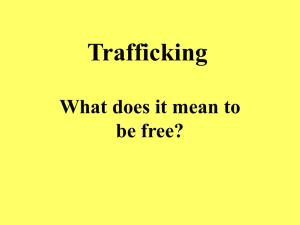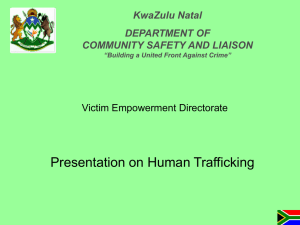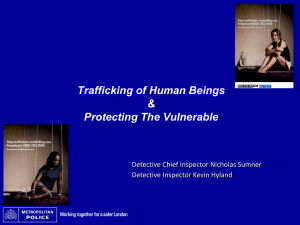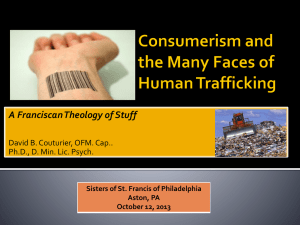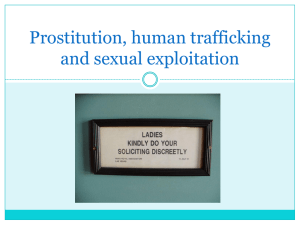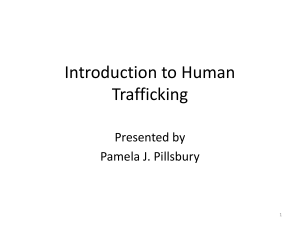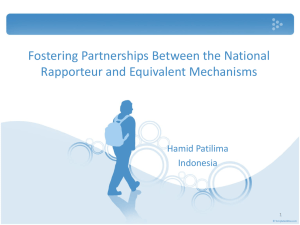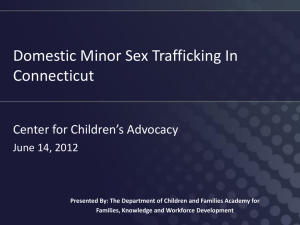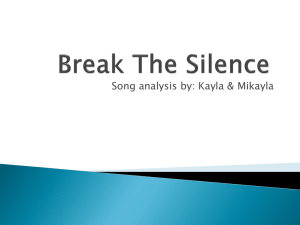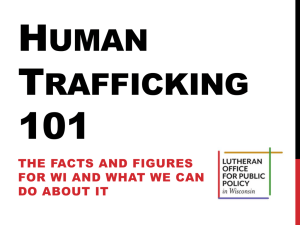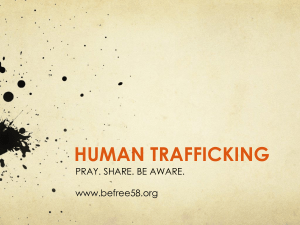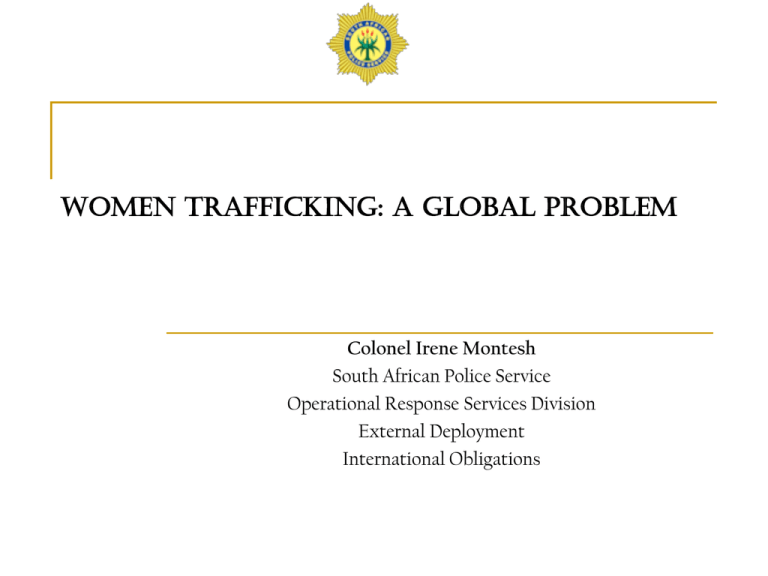
WOMEN TRAFFICKING: A GLOBAL PROBLEM
Colonel Irene Montesh
South African Police Service
Operational Response Services Division
External Deployment
International Obligations
PRESENTATION LAYOUT
HISTORICAL BACKGROUND
THE EXTENT OF THE PROBLEM
CAUSES OF THE PROBLEM
THE NETWORKS: ROLES WITHIN THE SMUGGLING NETWORKS
FACTORS CONTRIBUTING TO THE PROBLEM
LEGAL FRAMEWORK
International
Continental & regional frameworks
RECOMMENDATIONS
CONCLUSION
HISTORICAL BACKGROUND
Trafficking is often linked with women and girls sold into prostitution
Though it has now been recognized that this is only part of the picture, this
common association can be traced back to the origins of the trafficking
debate.
At the end of the nineteenth century, feminist activists like Josephine Butler
brought involuntary prostitution into the international picture under the
term “White Slave Trade”, which became popular and was used in several
treaties and laws.
The term “white slave trade” was derived from the French term “Traite des
Blanches”, which related to “Traite des Noirs”, a term used in the beginning
of the nineteenth century for the African slave trade.
The term was initially used to refer mainly to the trafficking of European and
American women for prostitution in western European countries and the
United States and from these countries to the colonies, but did not consider
the traffic in people from other races and colours
HISTORICAL BACKGROUND Cont …
As a result of continuous human trafficking, particularly
women, many European countries joined the United States
in a campaign to end the problem.
This media attention resulted in public outrage and an
increased awareness of the international traffic in women,
which eventually also contributed to the development of
several international initiatives to counter trafficking.
In 1904, thirteen states attended a meeting held in Paris,
resulting in an international agreement against white
slavery.
This agreement was the first of a series of agreements which
were superseded by the 1949 United Nations Convention
for the Suppression of the Traffic in Persons and of the
Exploitation of the Prostitution of Others.
Today, any form of human/women trafficking is prohibited
due to efforts that began long ago.
THE EXTENT OF THE PROBLEM
The U.S. State Department (2011) estimates that between 600,000
and 800,000 persons were trafficked across national borders
worldwide between April 2010 and March 2011.
80% of these were female, 70% of whom were trafficked for sexual
exploitation.
In 2010, between 14,500 and 17,500 were trafficked into the
United States.
These statistics are in line with those of the International Organization
for Migration 2011/2012.
CAUSES OF THE PROBLEM
The causes of women trafficking are complex and often reinforce
each other.
Viewing trafficking in persons as a global market, victims constitute
the supply, and abusive employers or sexual exploiters (also known
as sex buyers) represent the demand.
The supply of victims is encouraged by many factors including
poverty, the attraction of perceived higher standards of living
elsewhere, lack of employment opportunities, organized crime,
violence against women and children, discrimination against
women, government corruption, political instability, and armed
conflict.
In some societies a tradition of fostering allows the third or fourth
child to be sent to live and work in an urban centre with a member
of the extended family (often, an "uncle"), in exchange for a promise
of education and instruction in a trade (International Organization
for Migration, 2008:79)
CAUSES OF THE PROBLEM (Cont ….)
Push factors
According to the United Nations Office on Drugs and Crime (2009:70) the most common push
factors are:
high unemployment
labour market not open to women and gender discrimination
lack of opportunity to improve quality of life
sexual or ethnic discrimination; poverty
escaping persecution, violence or abuse
escaping human rights violations; collapse of social infrastructure
other environmental conditions including conflict and war
perception of increased opportunities available in developed countries
Pull factors
The United States State Department (2005:67) highlights some of the most common pull factors as
follows:
improved standard and quality of life; better higher education prospects
no discrimination or abuse; enforcement of minimum standards and individual rights
better employment opportunities
demand for cheap labour as well as the demand by men looking for commercial sex
higher salaries and better working conditions and the demand for workers within the sex industry
and higher earnings.
THE NEWTWORKS: ROLES WITHIN THE SMUGGLING NETWORKS
Berman (2011) outline the following roles within smuggling rings:
Management/supervising unit
Recruitment unit; Escort unit
Corrupted public officials
Guiding/navigating unit
Supporting/logistics unit
Debt collecting unit
Exploiting unit
Re-escort unit; Investors
Transporters; Informers
Guides and crew members
Enforcers; Debt-collectors
Money-launderers
Supporting personnel and specialists
FACTORS CONTRIBUTING TO THE PROBLEM: THE MARKET FOR
COMERCIAL SEX
Supply
The international proliferation of trafficking has created a supply of trafficked women that
is so large that it drives the market. Countries that make no attempt to control human
trafficking use the trade as a means of importing foreign currency, especially U.S. dollars
and Euros. This is achieved both by encouraging sex tourism in the originating country
and by tacitly approving the exportation of women to wealthy countries. Globalization
has facilitated the movement of cheap labour from one country to another
Demand
The demand issues surrounding trafficking for forced labour are simple enough
-because illegal or quasi-legal businesses can gain considerable advantage by
employing cheap labour, there will always be demand for such labour. In other
words, it is the market - the trafficking in women – that creates the demand, not
the customers. If there is a plentiful supply of vulnerable women and girls, a
profitable business plan follows: offer the services of young women that cater
to any customer preference at a competitive price and pay the women little or
nothing
LEGAL FRAMEWORK TO COMBAT TRAFFICKING IN PERSONS
International treaties/conventions
The Convention for the Suppression of the Traffic in Persons and of the Exploitation of the
Prostitution of Others of 1949.
The 1979 Convention on the Elimination of All Forms of Discrimination against Women of 1979
The Declaration on the Elimination of Violence against Women (General Assembly resolution
48/104 of 20 December 1993),
The Convention on the Rights of the Child of 1989
The Hague Convention on Protection of Children and Co-operation in respect of Inter-country
Adoption of 1993; The 1999 Convention to Eliminate the Worst Forms of Child Labour (ILO
Convention No. 182), of 1999
The International Convention on the Protection of the Rights of All Migrant Workers and Members
of Their Families (General Assembly resolution 45/158 of 18 December 1990
The Rome Statute of the International Criminal Court A/CONF. 183/9 of July 1998 as amended
Continental & Regional treaties
The Council of Europe Convention on Action against Trafficking in Human Beings of 2005
The Revised Arab Charter on Human Rights of the League of Arab States of 2004
The American Convention on Human Rights of 1969; The African Charter on Human and Peoples’
Rights of 1981; The 2003 Protocol to the African Charter on Human and Peoples’ Rights on the
Rights of Women in Africa 2003; The 2002 South Asian Association for Regional Cooperation
Convention on Preventing and Combating Trafficking in Women and Children for Prostitution of
2002; The 2001 Declaration on the Fight against Trafficking in Persons of the Economic
Community of West African States of 2001; The 1994 Inter-American Convention on International
Traffic in Minors of 1994
LEGAL FRAMEWORK TO COMBAT TRAFFICKING IN PERSONS(Cont)
South Africa: the Prevention of Trafficking in Persons Act 7 of 2013
has been signed into law. This is supplemented by “TSHIRELEDZANI
– South Africa Against Human Trafficking.
The SADC Regional Plan of Action on Trafficking in Persons is a ten-
year plan (2009-2019), based on the principles of human rights,
centred on the child, gender and non-criminalization of victims. The
SADC Plan of Action focuses on capacity building for the region,
including identifying trafficking as a crime, and providing victim
support and witness protection.
RECOMENDATIONS
Locating trafficked women (brothels, nail salons, bars, strip clubs
Identifying trafficked women (workers who are frightened to speak, domestic workers
who appear to be apprehensive or frightened, prostitutes who do not speak a local
language)
Protecting trafficked women (arrange medical assistance, contact NGO’s who
specialise in women issues)
Educate the public about human trafficking
Adopt an un-ambigous enforcement policy
Work jointly with Immigration and the Department of Labour officials
Use Asset Forfeiture Legislation to deal with traffickers
Punish the purchasers of sexual services and not sex trade workers
Change the attitudes of prostitution customers
Establish high visible police presence
Enforce zoning laws, nuisance abatement ordinances
Warn property owners about the use of their properties for prostitution
Enhance capacity of border control agencies
Improve law enforcement agencies to detect fraudulent travel documents
Improve international cooperation
C O N C L U S I O N
Addressing women trafficking requires a sharper strategy and an intelligent
implementation of theoretical and practical solutions. The starting point is for
the whole world to understand and objectively accept the existence of the
phenomenon as a serious international problem instead of somehow naively
denying it. Granted, the only viable option for eradicating women trafficking in
the foreseeable future is to fully cooperate and pool international human and
material resources in order to expand the capacity and to form robust strategic
alliances against crime and trafficking. LASTLY, police officials and the rest of
our society must stop “labelling” victims of Human/Women Trafficking as
CRIMINALS but instead we should treat them as victims of crime.


